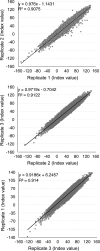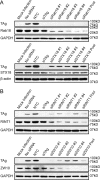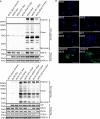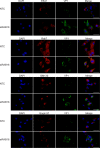Identification of Rab18 as an Essential Host Factor for BK Polyomavirus Infection Using a Whole-Genome RNA Interference Screen
- PMID: 28815213
- PMCID: PMC5555678
- DOI: 10.1128/mSphereDirect.00291-17
Identification of Rab18 as an Essential Host Factor for BK Polyomavirus Infection Using a Whole-Genome RNA Interference Screen
Abstract
BK polyomavirus (BKPyV) is a human pathogen first isolated in 1971. BKPyV infection is ubiquitous in the human population, with over 80% of adults worldwide being seropositive for BKPyV. BKPyV infection is usually asymptomatic; however, BKPyV reactivation in immunosuppressed transplant patients causes two diseases, polyomavirus-associated nephropathy and hemorrhagic cystitis. To establish a successful infection in host cells, BKPyV must travel in retrograde transport vesicles to reach the nucleus. To make this happen, BKPyV requires the cooperation of host cell proteins. To further identify host factors associated with BKPyV entry and intracellular trafficking, we performed a whole-genome small interfering RNA screen on BKPyV infection of primary human renal proximal tubule epithelial cells. The results revealed the importance of Ras-related protein Rab18 and syntaxin 18 for BKPyV infection. Our subsequent experiments implicated additional factors that interact with this pathway and suggest a more detailed model of the intracellular trafficking process, indicating that BKPyV reaches the endoplasmic reticulum (ER) lumen through a retrograde transport pathway between the late endosome and the ER. IMPORTANCE Polyomaviruses bind to a group of specific gangliosides on the plasma membrane of the cell prior to being endocytosed. They then follow a retrograde trafficking pathway to reach the endoplasmic reticulum (ER). The viruses begin to disassemble in the ER and then exit the ER and move to the nucleus. However, the details of intracellular trafficking between the endosome and the ER are largely unknown. By implementing a whole human genome small interfering RNA screen, we identified Rab18, syntaxin 18, and the NRZ complex as key components in endosome-ER trafficking of the human polyomavirus BKPyV. These results serve to further elucidate the route BKPyV takes from outside the cell to its site of replication in the nucleus.
Keywords: BKPyV; NRZ complex; Rab18; siRNA screen; syntaxin 18; virus trafficking.
Figures







Similar articles
-
A retrograde trafficking inhibitor of ricin and Shiga-like toxins inhibits infection of cells by human and monkey polyomaviruses.mBio. 2013 Nov 12;4(6):e00729-13. doi: 10.1128/mBio.00729-13. mBio. 2013. PMID: 24222489 Free PMC article.
-
Role of cell-type-specific endoplasmic reticulum-associated degradation in polyomavirus trafficking.J Virol. 2013 Aug;87(16):8843-52. doi: 10.1128/JVI.00664-13. Epub 2013 Jun 5. J Virol. 2013. PMID: 23740996 Free PMC article.
-
Caveolin- and clathrin-independent entry of BKPyV into primary human proximal tubule epithelial cells.Virology. 2016 May;492:66-72. doi: 10.1016/j.virol.2016.02.007. Epub 2016 Feb 19. Virology. 2016. PMID: 26901486 Free PMC article.
-
The human polyomavirus BK (BKPyV): virological background and clinical implications.APMIS. 2013 Aug;121(8):728-45. doi: 10.1111/apm.12134. Epub 2013 Jun 19. APMIS. 2013. PMID: 23782063 Review.
-
Diffuse gastrointestinal bleeding and BK polyomavirus replication in a pediatric allogeneic haematopoietic stem cell transplant patient.J Clin Virol. 2015 Jan;62:72-4. doi: 10.1016/j.jcv.2014.11.016. Epub 2014 Nov 18. J Clin Virol. 2015. PMID: 25542476 Review.
Cited by
-
Roles of lipid droplets and related proteins in metabolic diseases.Lipids Health Dis. 2024 Jul 19;23(1):218. doi: 10.1186/s12944-024-02212-y. Lipids Health Dis. 2024. PMID: 39030618 Free PMC article. Review.
-
Microtubules in Polyomavirus Infection.Viruses. 2020 Jan 18;12(1):121. doi: 10.3390/v12010121. Viruses. 2020. PMID: 31963741 Free PMC article. Review.
-
Massive entry of BK Polyomavirus induces transient cytoplasmic vacuolization of human renal proximal tubule epithelial cells.PLoS Pathog. 2024 Nov 21;20(11):e1012681. doi: 10.1371/journal.ppat.1012681. eCollection 2024 Nov. PLoS Pathog. 2024. PMID: 39570904 Free PMC article.
-
A Cell Culture Model of BK Polyomavirus Persistence, Genome Recombination, and Reactivation.mBio. 2021 Oct 26;12(5):e0235621. doi: 10.1128/mBio.02356-21. Epub 2021 Sep 2. mBio. 2021. PMID: 34473564 Free PMC article.
-
Taking the Scenic Route: Polyomaviruses Utilize Multiple Pathways to Reach the Same Destination.Viruses. 2020 Oct 15;12(10):1168. doi: 10.3390/v12101168. Viruses. 2020. PMID: 33076363 Free PMC article. Review.
References
Grants and funding
LinkOut - more resources
Full Text Sources
Other Literature Sources

